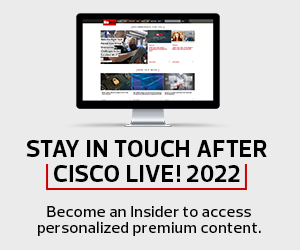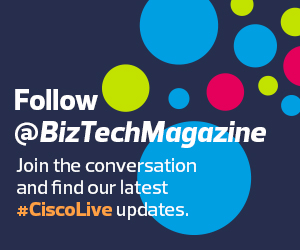The world is careening headlong toward a hybrid work future, but there are problems ahead — problems Cisco intends to solve.
So argued company executives in interviews and during the second-day keynote session of Cisco Live, the annual event for customers, partners, analysts and others taking place in Las Vegas. The experience of hybrid work too often leaves employees and businesses alike frustrated, they said.
“I live in constant fear that my cable modem’s going to go down and I’m going to get kicked off an important meeting,” said Todd Nightingale, Cisco’s executive vice president and general manager of enterprise networking and cloud. “And even when I call IT, they sometimes struggle to help me because I’m not on their network.”
Even when Wi-Fi works fine, what about the experience of remote employees during a meeting in which some or most participants are together in a room? “What’s the first thing people do when they’re in a room together?” asked Jeetu Patel, Cisco’s executive vice president and general manager of security and collaboration. “They start whiteboarding, and that means remote participants have no idea what’s going on.”
A poll of the keynote audience found that 53 percent described themselves as “still figuring it out” when it comes to hybrid work, with another 12 percent “just getting started.” Only 3 in 10 described themselves as “hybrid work rock stars.”
Click the banner below to receive exclusive industry content when you register as an Insider.
Employers Seek to Build Simple Hybrid Work Experiences
As employers strive to build hybrid work experiences, what many of them say they’re looking for is technology to “minimize the cognitive load” on employees who are forced to adapt to multiple work environments, said Lorrissa Horton, senior vice president and general manager of Webex calling and strategy.
“People don’t want to have to relearn how they work in the office when they’re only coming in one to three days a week,” she said. “I get used to my setup at home, and I come in and it’s like ‘Ugh, I don’t know how to work this room.’”
Although many technology companies operate in the collaboration space, Cisco has few rivals in terms of the comprehensiveness of its solution portfolio, which includes physical hardware, software and, increasingly, smart building technologies. At Cisco Live, the company touted those solutions:
- Hardware: Cisco’s portfolio of collaboration devices includes AI-powered cameras, conference room kits, desktop devices that enable videoconferences, headsets, digital whiteboards and more. The company offers every piece of hardware that a business might need to outfit a conference room, set up an office with hot desks or equip employees’ home offices.
- Software: Cisco’s Webex collaboration platform is one of the best-known brands in the space. The company has been upgrading the built-in features to better support a hybrid workforce. For example, to improve remote workers’ experience of hybrid meetings, the new Webex People Focus feature will zoom in on individual faces of in-office participants to create a video “box” for each person, making such meetings appear just like all-remote videoconferences with which workers are already familiar.
- Smart Buildings: With its own and partners’ technologies, Cisco is moving into equipping offices with smart technologies that allow administrators to do everything remotely, from controlling room temperatures to adjusting lighting and more. Location analytics will offer insights into how people move around physical spaces.
“The way a lot of us have done hybrid work is to spend all day hunched over our laptops, and that’s no way to spend eight hours,” Patel said. “Just like the Kindle is a purpose-built device for reading a book, we have purpose-built devices for making sure you can engage with your work experience from home.”
Stay updated on the latest updates and insights from BizTech.
The Whiteboard Has Entered the Modern Era
Of particular interest to some attendees was the advancements Cisco has made in its whiteboarding technology. Its Webex Board physical whiteboards integrate seamlessly with the whiteboard application within the Webex collaboration platform. As workers brainstorm ideas on the digital whiteboard hanging in their conference room, their remote colleagues can see what they’re writing in real time within Webex, and can add their own ideas.
“One of the problems we’re trying to solve is that, in the office, a lot of times people will say, ‘Well, here’s what I’m trying to explain,’ and they just start writing,” Horton said. “But what if the person you’re trying to explain it to is not in the same room? This is a basic challenge that occurs across every team size in every industry. And now you can bring that person, and they can add to the whiteboard at the same time. If anything, it’s a little better than being in person.”
Whether you’re attending Cisco Live or not, follow us on Twitter at @BizTechMagazine and the official conference Twitter account, @CiscoLive, and join the conversation using hashtag #CLUS.













